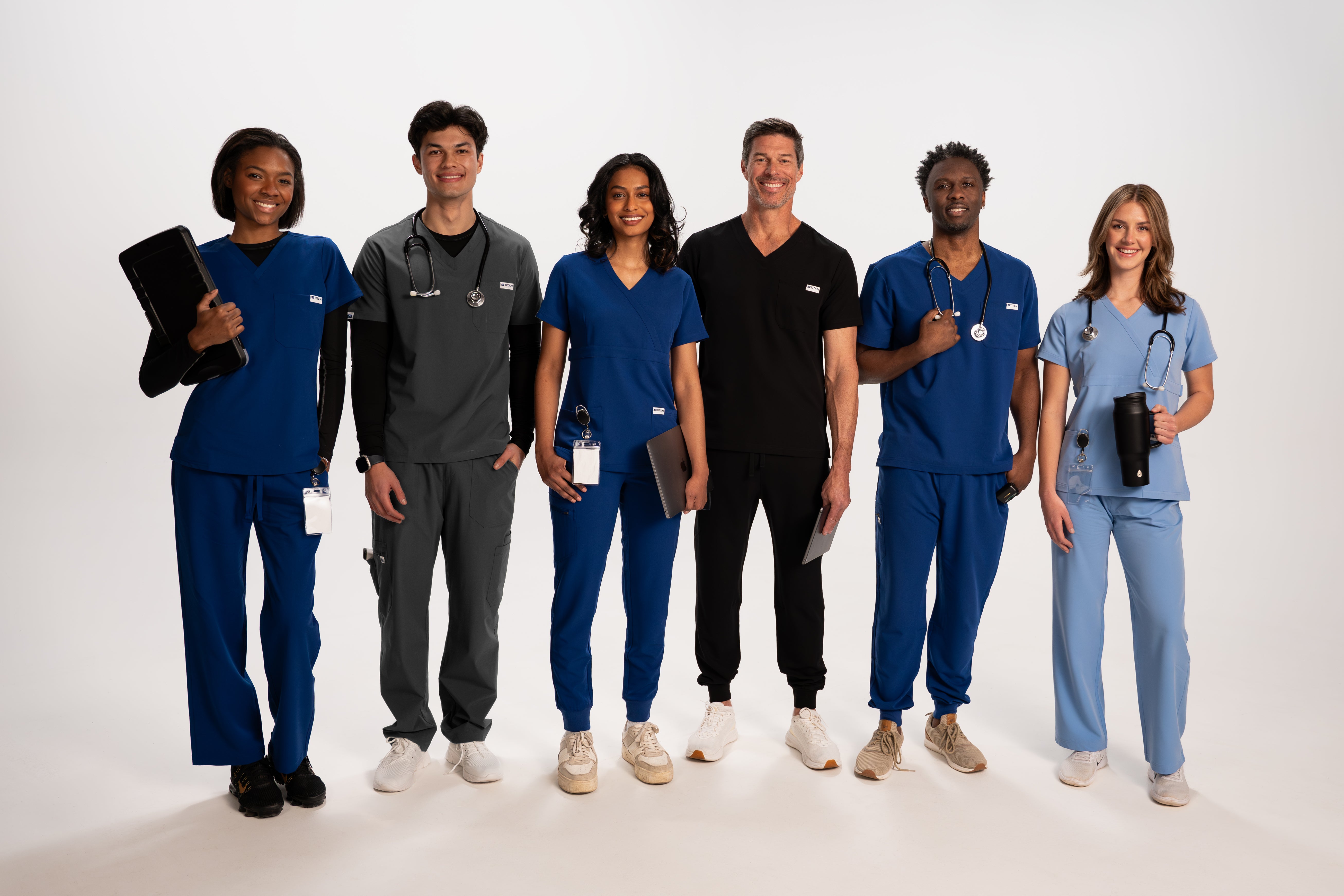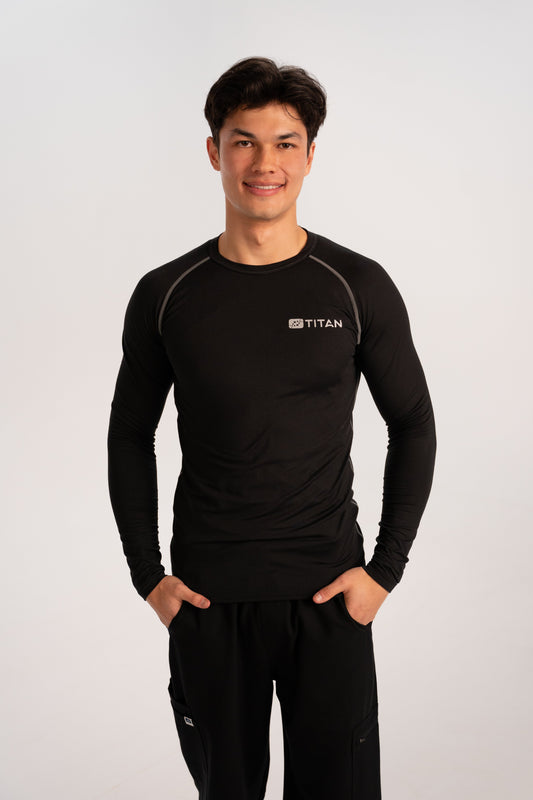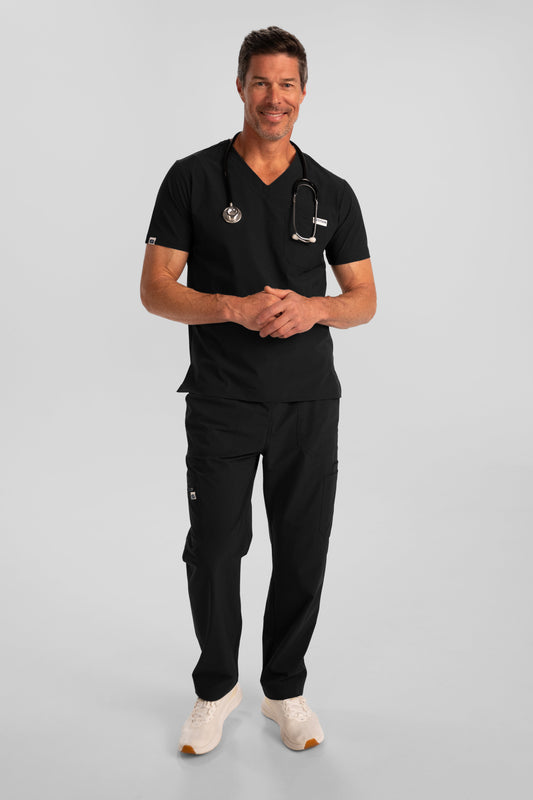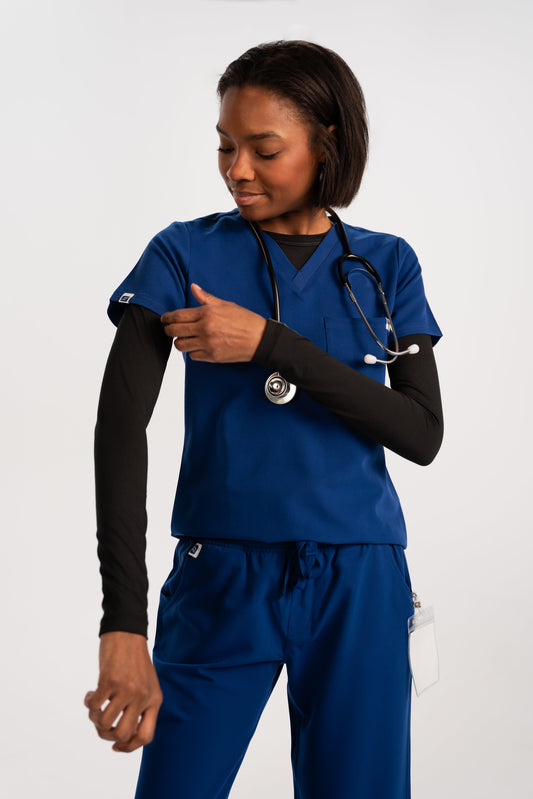Why Scrub Fabric Matters More Than You Think
When most people shop for scrubs, they focus on fit, color, or pocket count. And while those features matter, they often overlook something even more important: fabric. What your scrubs are made of has a direct impact on how you feel, how you perform, and how long your uniform lasts.
For healthcare professionals working long, physically demanding shifts — often in high-pressure environments — fabric isn’t just a comfort choice. It’s a performance tool.
Moisture control, breathability, odor resistance, mobility, and durability all hinge on what materials are used. And in a world where fast fashion has crept into the medical apparel industry, understanding the difference between basic and performance fabrics is more essential than ever.
Let’s start by looking at the four most common types of scrub fabric — and where they fall short.
Comparing the Most Common Scrub Fabrics
Cotton: Comfortable, but Not Built for the Job
Cotton is the fabric many of us grew up with. It’s soft, breathable, and familiar — which makes it a default choice for casual wear. But in a clinical setting, its shortcomings become obvious fast.
-
Absorbs moisture but dries slowly, leaving you damp during long shifts
-
Shrinks and fades with repeated washing
-
Offers limited stretch, making it restrictive for active movement
-
Becomes heavy and clingy when wet
Cotton may feel great at the start of your shift, but by hour six, it’s working against you.
Polyester: Durable and Quick-Drying, But Not Always Comfortable
Polyester is a synthetic fiber known for strength and water resistance. It dries faster than cotton and resists fading or shrinking. It’s also more wrinkle-resistant, which is a plus for healthcare workers on the go.
However, polyester on its own isn’t known for softness. In scrubs made entirely of polyester, the comfort and breathability often take a hit — especially in warmer environments. That’s why you’ll usually find it used as part of a fabric blend rather than the sole material.
Rayon: Soft and Breathable, but Weak on Durability
Rayon is a semi-synthetic fabric often added to scrub blends for a softer, silkier feel. It’s lightweight, breathable, and drapes nicely, which makes it popular among brands focused on fashion-forward fit.
But there’s a trade-off: rayon isn’t durable. It pills easily, wrinkles quickly, and doesn’t stand up to high-heat drying cycles or repeated washing. It’s comfort-focused, but not ideal for scrubs expected to last.
Spandex/Elastane: Excellent Stretch, Best in Small Doses
Spandex (also called elastane or Lycra) is what gives modern scrubs their much-loved stretch. You’ll often see it included at 2–10% in performance scrub blends.
Used in the right ratio, spandex improves mobility and recovery — meaning your scrubs snap back into shape instead of bagging or stretching out. But it’s not a stand-alone solution. Scrubs made entirely of spandex would be uncomfortable and impractical. It’s a supporting player, not the main act.
The Problem with “Traditional” Scrub Fabrics
Individually, these fabrics all have strengths. Cotton feels nice. Polyester lasts. Rayon breathes. Spandex stretches. But none of them — even in combinations — offer everything today’s medical professionals need.
-
Long shifts generate heat and sweat — cotton can’t manage it
-
Constant movement requires stretch — polyester can’t provide it alone
-
Frequent washes demand durability — rayon won’t survive long
-
And none of them offer built-in odor control without chemical treatments
That’s the limitation of traditional fabrics: they were never made for high-performance environments. They were adapted for scrubs, but not engineered for them.
And that brings us to the shift happening in medical apparel right now — and the rise of true performance fabrics.
The Rise of Performance Fabrics in Healthcare Apparel
Just like pro athletes traded in cotton for dry-fit jerseys and quick-dry compression gear, healthcare professionals are moving toward scrubs designed with science-backed fabric engineering.
The demands are similar:
-
Long hours
-
Constant movement
-
High heat and sweat
-
Frequent wear and wash
-
Need for flexibility, breathability, and quick recovery
It’s no coincidence that many of the innovations showing up in modern scrubs were born in the world of elite sportswear. As expectations for workwear rise, so does the bar for performance.
Traditional fabric blends simply aren’t enough anymore. Healthcare workers are asking for more — and rightly so.
What Makes driRelease® a Game-Changer for Scrubs
One of the leading fabric technologies answering this call is driRelease® — a performance-engineered material designed to deliver moisture-wicking, odor control, breathability, and durability without relying on chemical coatings.
Here’s what makes it different:
Moisture-Wicking That Works
Unlike cotton, which holds onto moisture, and polyester, which repels it but doesn't manage it well, driRelease® actively pulls sweat away from your skin, spreads it across the fabric, and helps it evaporate quickly. That means you stay drier, longer, even during intense or warm shifts.
Built-In Odor Resistance (No Chemicals Needed)
Many brands treat their fabrics with temporary antimicrobial finishes to control odor — but those treatments wash out after a few cycles. driRelease® takes a smarter approach. The odor control is inherent to the fiber structure, meaning it won’t fade, wash out, or require special care.
Quick-Drying and Lightweight
This isn’t a minor benefit — it’s a game-changer. Quick-drying scrubs mean less post-shift chill, especially in air-conditioned spaces or during PPE changes. It also means faster laundry turnarounds and less downtime waiting for scrubs to dry.
No Post-Treatment Coatings
Many “tech fabrics” on the market today advertise moisture-wicking or odor control — but rely on chemical coatingsthat diminish over time. driRelease® is different. Its performance is built into the yarn itself, so it doesn’t wash away. That means what works on day one will still work on day one hundred.
Why Titan Scrubs Chose Optimer’s driRelease® Fabric
When Titan Scrubs set out to design medical apparel, it wasn’t about chasing trends. It was about building something better — smarter — stronger. Something that healthcare workers would feel the difference in the moment they put it on.
That’s why Titan partnered with Optimer Technologies to license driRelease® — the same performance fabric used by the world’s top three athletic apparel brands. Titan is currently the only scrubs company licensed to use driRelease®, setting it apart in a market filled with watered-down performance promises.
This partnership gives Titan Scrubs:
-
Access to athletic-grade technology proven in the most physically demanding settings
-
Exclusive rights to a fabric trusted by elite athletes and now adapted for healthcare
-
A performance edge that delivers true comfort, durability, and breathability without compromise
This isn’t just about luxury. It’s about functionality. It’s about giving healthcare professionals gear that works as hard as they do.
Final Thoughts: Choosing the Right Fabric for Your Workday
When it comes to scrubs, fabric isn’t just a preference — it’s a performance decision. You can choose materials that were never meant for your job, or you can choose scrubs engineered to support it.
Here’s what to look for:
-
Moisture-wicking that lasts
-
Odor control without chemicals
-
Quick-dry performance
-
Flexibility and strength
-
Proven durability through frequent use and washing
Titan Scrubs offers all of that — because we believe healthcare professionals deserve the same level of performance and quality that pro athletes do.
If you're still choosing scrubs based on color or brand name alone, it's time to go deeper. Ask what they're made of — and what they're made for.
Because the best fabric for scrubs?
It’s not just about softness.
It’s about supporting you at your best.









